Scientific Session
Hyperpolarized MR
Session Topic: Hyperpolarized MR
Session Sub-Topic: New Frontiers in Hyperpolarization
Oral
Molecular Imaging
| Tuesday Parallel 5 Live Q&A | Tuesday, 11 August 2020, 15:15 - 16:00 UTC | Moderators: Jessica Bastiaansen & Franz Schilling |
Session Number: O-46
0693.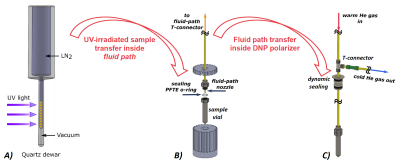 |
Transportable hyperpolarized glucose samples: towards remote dissolution DNP
Andrea Capozzi1,2, Jan Kilund1, Magnus Karlsson1, Mathilde Hauge Lerche1, and Jan Henrik Ardenkjaer-Larsen1
1Health Technology, Danish Technical University, Kongens Lyngby, Denmark, 2IPHYS, EPFL, Lausanne, Switzerland
Our vision is to enable delivery of hyperpolarized compounds to MR-facilities that currently have no access to hyperpolarization technology. Today this is not the case and represents a main shortcoming of hyperpolarized-MR via dissolution Dynamic Nuclear Polarization (dDNP). The cause is the presence, in the dDNP sample, of organic free radicals necessary to generate the hyperpolarization. We herein present a paradigm shift in the technique built on the employment of photo-induced thermally-labile free radicals. We demonstrate quenching of the paramagnetic species while preserving most of the polarization in the case of hyperpolarized glucose.
|
|
 |
0694.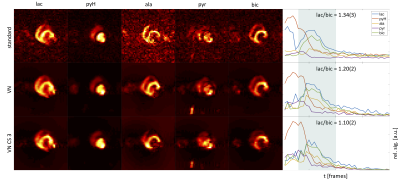 |
Accelerating cardiac hyperpolarized 13C imaging using variational networks for reconstruction
Andreas Dounas1, Valery Vishnevskiy1, Maximilian Fuetterer1, Julia Traechtler1, and Sebastian Kozerke1
1Institute for Biomedical Engineering, University and ETH Zurich, Zurich, Switzerland
A variational network (VN) was implemented and trained on synthetic data to reconstruct multi-echo hyperpolarized 13C data acquired in the in vivo heart. VN reconstruction performance was studied using 2D and 3D synthetic data under low SNR conditions and for acceleration factors of 3 and 9, respectively. Relative to standard gradient descent based reconstruction, the network offers improved reconstruction accuracy and reduced signal leakage between metabolites while preserving information on lactate-to-bicarbonate ratios.
|
 |
0695.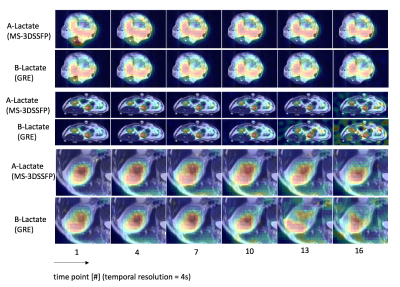 |
A Metabolite Specific 3D Stack-of-Spiral bSSFP Sequence for Improved Lactate Imaging in Hyperpolarized [1-13C]Pyruvate Studies on a 3T Scanner
Shuyu Tang1, Robert Bok1, Hecong Qin1, Galen Reed2, Mark VanCriekinge1, Romelyn Delos Santos1, William Overall2, Juan Santos2, Jeremy Gordon1, Zhen J. Wang1, Daniel Vigneron1, and Peder E.Z. Larson1
1University of California, San Francisco, San Francisco, CA, United States, 2HeartVista, Los Altos, CA, United States
This work describes a novel 3D bSSFP sequence that integrates a lactate specific excitation pulse and stack-of-spiral readouts for improved lactate dynamic imaging in hyperpolarized [1-13C]pyruvate studies on a clinical 3T scanner. Compared with metabolite specific GRE sequences, the MS-3DSSFP sequence showed an overall 2.5X SNR improvement for lactate imaging in rat kidneys, tumors of TRAMP mice and human kidneys.
|
0696. |
Providing a clinical pipeline for using the sodium-23 resonance to calibrate for in vivo hyperpolarized carbon-13 experiments.
James Timothy Grist1,2, Esben S Hansen3, Juan D Sanchez4, Mary A McLean5, Frank Riemer6, Rolf F Schulte7, Jan Henrik Ardenkjaer-Larsen4, Christoffer Laustsen3, and Ferdia A Gallagher6
1Unviesity of Cambridge, Cambridge, United Kingdom, 2University of Birmingham, Birmingham, United Kingdom, 3Aarhus University, Aarhus, Denmark, 4Technical University of Denmark, Copenhagen, Denmark, 5Cancer Research UK, Cambridge Institute, University of Cambridge, Cambridge, United Kingdom, 6University of Cambridge, Cambridge, United Kingdom, 7GE Healthcare, Munich, Germany
Hyperpolarized 13C MRI is an emerging clinical technique to probe metabolism. Calibration of transmit gain and centre frequency is challenging, due to the low endogenous 13C signal. Pre-scan is typically performed by adding an external phantom for reference, however this is challenged by the shim volume inside the subject and the RF coil excitation and receptions profiles. We demonstrate the ability to use the sodium-23 resonance to accurately prescan prior to 13C experiments, using single tuned 13C coils in a 3T MRI system. This provides an important workflow improvement for the adoption of hyperpolarized 13C imaging into clinical practise.
|
|
0697.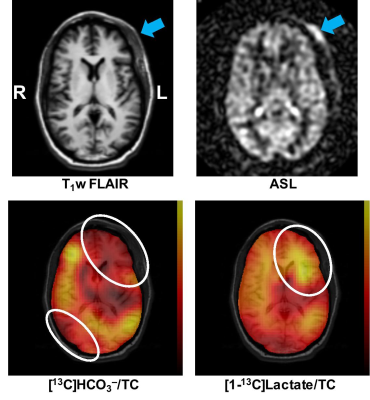 |
Imaging Acute Metabolic Changes in Mild Traumatic Brain Injury Patients using Hyperpolarized [1-13C]Pyruvate
Edward P Hackett1, Marco C Pinho2, Crystal E Harrison1, Galen D Reed3, Surendra Barshikar4, Christopher J Madden5, and Jae Mo Park1,2,6
1Advanced Imaging Research Center, University of Texas Southwestern Medical Center, Dallas, TX, United States, 2Radiology, University of Texas Southwestern Medical Center, Dallas, TX, United States, 3GE Healthcare, GE Healthcare, Dallas, TX, United States, 4Physical Medicine and Rehabilitation, University of Texas Southwestern Medical Center, Dallas, TX, United States, 5Neurosurgery, University of Texas Southwestern Medical Center, Dallas, TX, United States, 6Electrical Engineering, University of Texas Dallas, Richardson, TX, United States
A major challenge of treating traumatic brain injury (TBI) patients is the simultaneously occurring complex secondary injury processes following the primary injury. The secondary events such as cerebral hyperglycolysis and mitochondrial failure develop over minutes to months after the primary injury. This case report details the first time hyperpolarized [1-13C]pyruvate imaging in TBI patients to examine regional metabolic changes in the brain post-traumatic injury. We observed an increased conservation of pyruvate to lactate at the injured sites as well as reduced bicarbonate production.
|
|
0698.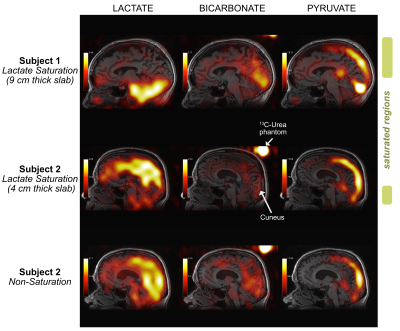 |
Is [1-13C]Lactate Converted to 13C-Bicarbonate in the Human Brain?
Casey Y Lee1,2, Hany Soliman3, Nadia D Bragagnolo1,2, Albert P Chen4, William J Perks5, Chris Heyn6, Sandra E Black7, and Charles H Cunningham1,2
1Medical Biophysics, University of Toronto, Toronto, ON, Canada, 2Physical Sciences, Sunnybrook Research Institute, Toronto, ON, Canada, 3Radiation Oncology, Sunnybrook Health Sciences Centre, Toronto, ON, Canada, 4GE Healthcare Technologies, Toronto, ON, Canada, 5Pharmacy, Sunnybrook Health Sciences Centre, Toronto, ON, Canada, 6Radiology, Sunnybrook Health Sciences Centre, Toronto, ON, Canada, 7Department of Medicine (Neurology) and Hurvitz Brain Sciences Research Program, Sunnybrook Health Sciences Centre, Toronto, ON, Canada
Hyperpolarized [1-13C]lactate and 13C-bicarbonate images were acquired with and without spectral-spatial lactate saturation in the brains of control participants. A previously published atlas-based analysis was used to convert [1-13C]lactate and 13C-bicarbonate signals into z-scores to quantify the effect of [1-13C]lactate saturation. The analysis showed that lactate z-scores were changed in the saturation regions, as expected. The saturation of [1-13C]lactate signals did not significantly affect 13C-bicarbonate signals.
|
|
0699.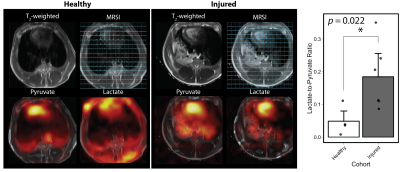 |
Metabolic Imaging of a Porcine Model of Acute Lung Injury Using Hyperpolarized [1-13C] Pyruvate MRI
Mehrdad Pourfathi1, Hooman Hamedani1,2, Yi Xin1,2, Michael Rosalino1, Stephen J Kadlecek1, Ian Duncan1, Maurizio Cereda1,3, Sarmad Siddiqui1, Harrilla Profka1, Luis Loza1, Faraz Amzajerdian 1,2, Tahmina Achekzai1, Kai Ruppert1,
Federico Sertic1,4, Ryan Baron1, Jon Snow1, Yiwen Qian1,2, Gabriel Unger1, Shampa Chatterjee5, and Rahim R. Rizi1
1Radiology, University of Pennsylvania, Philadelphia, PA, United States, 2Bioengineering, University of Pennsylvania, Philadelphia, PA, United States, 3Anesthesiology and Critical Care, University of Pennsylvania, Philadelphia, PA, United States, 4Surgery, University of Pennsylvania, Philadelphia, PA, United States, 5Physiology, University of Pennsylvania, Philadelphia, PA, United States
Transpulmonary lactate gradient is strongly correlated with the severity of lung injury and inflammation in ARDS patients. Hyperpolarized [1-13C] pyruvate MRI allows us to quantitatively study altered pyruvate-to-lactate conversion in cancerous and inflamed tissues. We sought to demonstrate the translational potential of this technology for pulmonary metabolic imaging in humans. We performed [1-13C] pyruvate lung MRI in an experimental model of aspiration pneumonitis in pigs, demonstrating this technology’s capacity to detect changes in pulmonary anaerobic metabolism after inflammatory injury in larger species.
|
|
0700.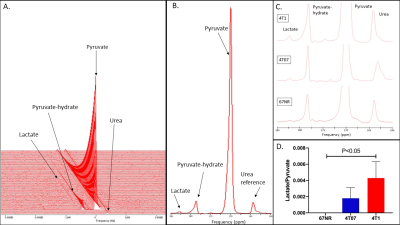 |
Investigation of Dormant and Metastatic Breast Cancer Metabolism via Hyperpolarized 13C-MRS and Fluorescence Lifetime Imaging Microscopy
Paul Begovatz1, Sarah Erickson-Bhatt2,3,4, Benjamin Cox2, Suzanne Ponik4, Kevin Eliceiri1,2,3, and Sean Fain1,5,6
1Medical Physics, University of Wisconsin-Madison, Madison, WI, United States, 2Morgridge Institute for Research, Madison, WI, United States, 3Laboratory for Optical and Computational Instrumentation, University of Wisconsin-Madison, Madison, WI, United States, 4Cell and Regenerative Biology, University of Wisconsin-Madison, Madison, WI, United States, 5Radiology, University of Wisconsin-Madison, Madison, WI, United States, 6Biomedical Engineering, University of Wisconsin-Madison, Madison, WI, United States
Hyperpolarized 13C-Magnetic resonance spectroscopy (13C-MRS) and NADH fluorescence lifetime imaging (FLIM) have evolved as methods to detect metabolic shifts in aerobic glycolysis and oxidative phosphorylation which are associated with metastatic potential in cancer metabolism. This study set out to investigate the differences in cancer metabolism between murine non-metastatic, metastatic-dormant, and highly metastatic breast cancer cell lines. FLIM analysis revealed no differences in free and bound NADH between cell lines, indicative of uniform ATP production through oxidative phosphorylation; however, hyperpolarized 13C-MRS measurements detected an increase in lactate production, or aerobic glycolysis, which was associated with greater breast cancer metastatic potential.
|
|
0701.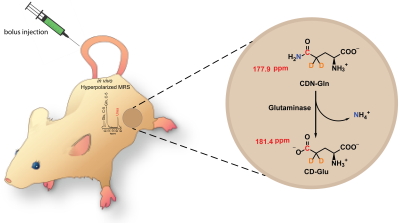 |
In Vivo Spectroscopic Detection of Glutaminase Enzyme Activity with Hyperpolarized [5-13C,4-2H2,5-15N]-L-Glutamine
Roozbeh Eskandari1, Arsen Mamakhanyan1, Kristin L Granlund1, Kayvan R Keshari1, and Craig B Thompson2
1Radiology, Memorial Sloan Kettering Cancer Center, New York, NY, United States, 2Cancer Biology & Genetics, Memorial Sloan Kettering Cancer Center, New York, NY, United States
Aberrations in glutaminase enzyme expression are associated with a variety of pathologies, and an in vivo probe to quantify flux through this pathway may provide a new layer of information. We developed a custom-synthesized compound, [5-13C,4-2H2,5-15N]-L-Glutamine, as a hyperpolarized MRI probe for glutaminase activity. Triple labeling of glutamine and D2O solvation reduces quadrupolar relaxation and extends both T1 and T2, facilitating in vivo imaging. We were able to acquire 13C spectroscopic data on a subcutaneous RCC xenograft murine model and detect in vivo conversion of hyperpolarized glutamine to glutamate, which permits further exploration of this imaging probe in the future.
|
|
0702.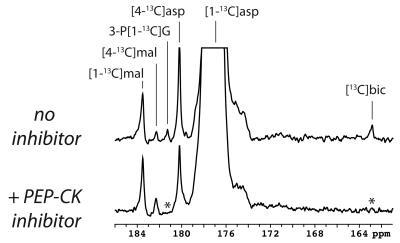 |
Detection of renal PEP-CK activity with hyperpolarized 13C-aspartate
Hikari A. I. Yoshihara1 and Juerg Schwitter2,3
1Laboratory for Functional and Metabolic Imaging, Swiss Federal Institute of Technology (EPFL), Lausanne, Switzerland, 2Division of Cardiology, Lausanne University Hospital (CHUV), Lausanne, Switzerland, 3Cardiac MR Center, Lausanne University Hospital (CHUV) and University of Lausanne (UNIL), Lausanne, Switzerland
Renal gluconeogenesis contributes to glucose homeostasis and is elevated in diabetes. Aspartate is an efficient gluconeogenic substrate in the kidney, and its conversion to glucose proceeds via phosphoenolpyruvate carboxykinase (PEP-CK), which is a rate-limiting enzyme. Scanning the kidney of rats infused with hyperpolarized [1-13C]aspartate, the metabolites detected include [1-13C]malate and [4-13C]malate, 3-phospho[1-13C]glycerate, and a trace of bicarbonate. Using [1,4-13C2]aspartate resulted in higher bicarbonate signal, consistent with PEP-CK activity, and bicarbonate was undetectable after inhibiting PEP-CK. Compared to fed rats, the bicarbonate-to-malate ratio was 3-fold higher in fasted rats, indicating the potential of hyperpolarized aspartate to probe renal gluconeogenesis.
|

 Back to Program-at-a-Glance
Back to Program-at-a-Glance Watch the Video
Watch the Video Back to Top
Back to Top